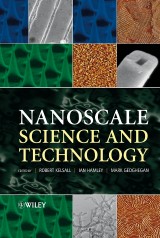Details

Nanoscale Science and Technology
1. Aufl.
|
88,99 € |
|
| Verlag: | Wiley |
| Format: | |
| Veröffentl.: | 01.11.2005 |
| ISBN/EAN: | 9780470020869 |
| Sprache: | englisch |
| Anzahl Seiten: | 472 |
DRM-geschütztes eBook, Sie benötigen z.B. Adobe Digital Editions und eine Adobe ID zum Lesen.
Beschreibungen
Nanotechnology is a vital new area of research and development addressing the control, modification and fabrication of materials, structures and devices with nanometre precision and the synthesis of such structures into systems of micro- and macroscopic dimensions. Future applications of nanoscale science and technology include motors smaller than the diameter of a human hair and single-celled organisms programmed to fabricate materials with nanometer precision.<br /> <br /> Miniaturisation has revolutionised the semiconductor industry by making possible inexpensive integrated electronic circuits comprised of devices and wires with sub-micrometer dimensions. These integrated circuits are now ubiquitous, controlling everything from cars to toasters. The next level of miniaturisation, beyond sub-micrometer dimensions into nanoscale dimensions (invisible to the unaided human eye) is a booming area of research and development. This is a very hot area of research with large amounts of venture capital and government funding being invested worldwide, as such Nanoscale Science and Technology has a broad appeal based upon an interdisciplinary approach, covering aspects of physics, chemistry, biology, materials science and electronic engineering. Kelsall et al present a coherent approach to nanoscale sciences, which will be invaluable to graduate level students and researchers and practising engineers and product designers.
List of contributors. <p>Preface.</p> <p>Chapter authors.</p> <p><b>1 Generic methodologies for nanotechnology: classification and fabrication.</b></p> <p>1.1 Introduction and classification.</p> <p>1.2 Summary of the electronic properties of atoms and solids.</p> <p>1.3 Effects of the nanometre length scale.</p> <p>1.4 Fabrication methods.</p> <p>1.5 Preparation, safety and storage issues.</p> <p>Bibliography.</p> <p><b>2 Generic methodologies for nanotechnology: characterization.</b></p> <p>2.1 General classification of characterization methods.</p> <p>2.2 Microscopy techniques.</p> <p>2.3 Electron microscopy.</p> <p>2.4 Field ion microscopy.</p> <p>2.5 Scanning probe techniques.</p> <p>2.6 Diffraction techniques.</p> <p>2.7 Spectroscopy techniques.</p> <p>2.8 Surface analysis and depth profiling.</p> <p>2.9 Summary of techniques for property measurement.</p> <p>Bibliography.</p> <p><b>3 Inorganic semiconductor nanostructures.</b></p> <p>3.1 Introduction.</p> <p>3.2 Overview of relevant semiconductor physics.</p> <p>3.3 Quantum confinement in semiconductor nanostructures.</p> <p>3.4 The electronic density of states.</p> <p>3.5 Fabrication techniques.</p> <p>3.6 Physical processes in semiconductor nanostructures.</p> <p>3.7 The characterisation of semiconductor nanostructures.</p> <p>3.8 Applications of semiconductor nanostructures.</p> <p>3.9 Summary and outlook.</p> <p>Bibliography.</p> <p><b>4 Nanomagnetic materials and devices.</b></p> <p>4.1 Magnetism.</p> <p>4.2 Nanomagnetic materials.</p> <p>4.3 Magnetoresistance.</p> <p>4.4 Probing nanomagnetic materials.</p> <p>4.5 Nanomagnetism in technology.</p> <p>4.6 The challenges facing nanomagnetism.</p> <p>Bibliography.</p> <p><b>5 Processing and properties of inorganic nanomaterials.</b></p> <p>5.1 Introduction.</p> <p>5.2 The thermodynamics and kinetics of phase transformations.</p> <p>5.3 Synthesis methods.</p> <p>5.4 Structure.</p> <p>5.5 Microstructural stability.</p> <p>5.6 Powder consolidation.</p> <p>5.7 Mechanical properties.</p> <p>5.8 Ferromagnetic properties.</p> <p>5.9 Catalytic properties.</p> <p>5.10 Present and potential applications for nanomaterials.</p> <p>Bibliography.</p> <p><b>6 Electronic and electro-optic molecular materials and devices.</b></p> <p>6.1 Concepts and materials.</p> <p>6.2 Applications and devices.</p> <p>6.3 Carbon nanotubes.</p> <p>Appendix: Reference table of organic semiconductors.</p> <p>Bibliography.</p> <p><b>7 Self-assembling nanostructured molecular materials and devices.</b></p> <p>7.1 Introduction.</p> <p>7.2 Building blocks.</p> <p>7.3 Principles of self-assembly.</p> <p>7.4 Self-assembly methods to prepare and pattern nanoparticles.</p> <p>7.5 Templated nanostructures.</p> <p>7.6 Liquid crystal mesophases.</p> <p>7.7 Summary and outlook.</p> <p>Bibliography.</p> <p><b>8 Macromolecules at interfaces and structured organic films.</b></p> <p>8.1 Macromolecules at interfaces.</p> <p>8.2 The principles of interface science.</p> <p>8.3 The analysis of wet interfaces.</p> <p>8.4 Modifying interfaces.</p> <p>8.5 Making thin organic films.</p> <p>8.6 Surface effects on phase separation.</p> <p>8.7 Nanopatterning surfaces by self-assembly.</p> <p>8.8 Practical nanoscale devices exploiting macromolecules at interfaces.</p> <p>Bibliography.</p> <p><b>9 Bionanotechnology.</b></p> <p>9.1 New tools for investigating biological systems.</p> <p>9.2 Biomimetic nanotechnology.</p> <p>9.3 Conclusions.</p> <p>Bibliography.</p> <p>Index.</p>
"…a refreshing work, a very readable introduction to nanotechnology…" (<i>CHOICE</i>, February 2006 ) <p>“ …the book reads well (and) abounds with instructive diagrams …” (<i>Chemistry World</i>, July 2005)</p>
<p><strong>Robert W Kelsall</strong> is Course director for the joint Leeds/Sheffield MSc in Nanoscale Science and Technology, which was one of the first (and is currently one of the largest) taught postgraduate nanotechnology programmes to be established in Europe. <strong>Ian Hamley</strong> and <strong>Mark Geoghegan</strong> are both actively involved in the delivery of the course. All three Editors manage substantial research programmes covering low-dimensional semiconductor devices, structured surfaces and interfaces, polymers and soft matter.
<i>Nanoscale Science and Technology</i> covers the whole spectrum of nanotechnology, from electronic and magnetic nanostructures to molecular self-assembly and bio-nanotechnology. Written by a team of experts, this book offers specialist analyses of each particular topic, all seamlessly integrated into a fully cross-referenced volume. <p>Maintaining an interdisciplinary approach that addresses aspects of physics, chemistry, biology, materials science and electronic engineering, this book:</p> <ul> <li>presents a coherent approach to nanoscale sciences, consistent in technical level, extent of coverage, and educational style;</li> <li>illustrates important features of each individual area of investigation, using representative examples of research results; and</li> <li>discusses the key breakthroughs and future development of nanoscale science and technology.</li> </ul> <p><i>Nanoscale Science and Technology</i> provides an invaluable resource for all who are entering the field of nanotechnology. It is an essential tool for graduates studying nanotechnology-related subjects at postgraduate level, postdoctoral research assistants and final year undergraduates taking nanotechnology options or projects. Industrial research scientists and research directors will also find this book to be an important reference.</p>
Diese Produkte könnten Sie auch interessieren:

Scaling Issues and Design of MEMS

von: Salvatore Baglio, Salvatore Castorina, Nicolo Savalli

110,99 €















